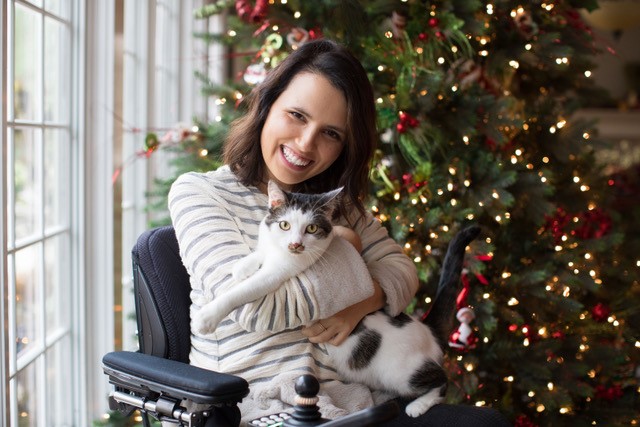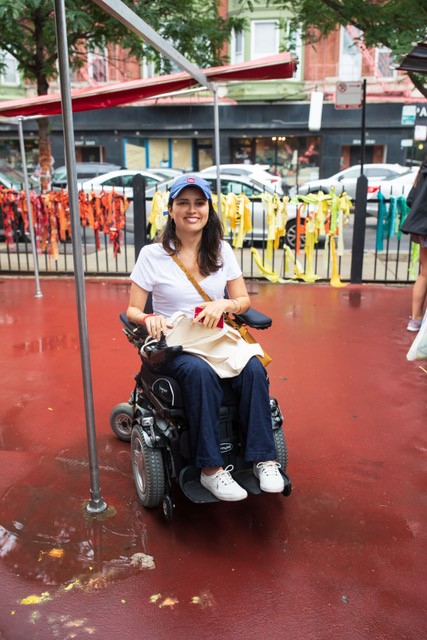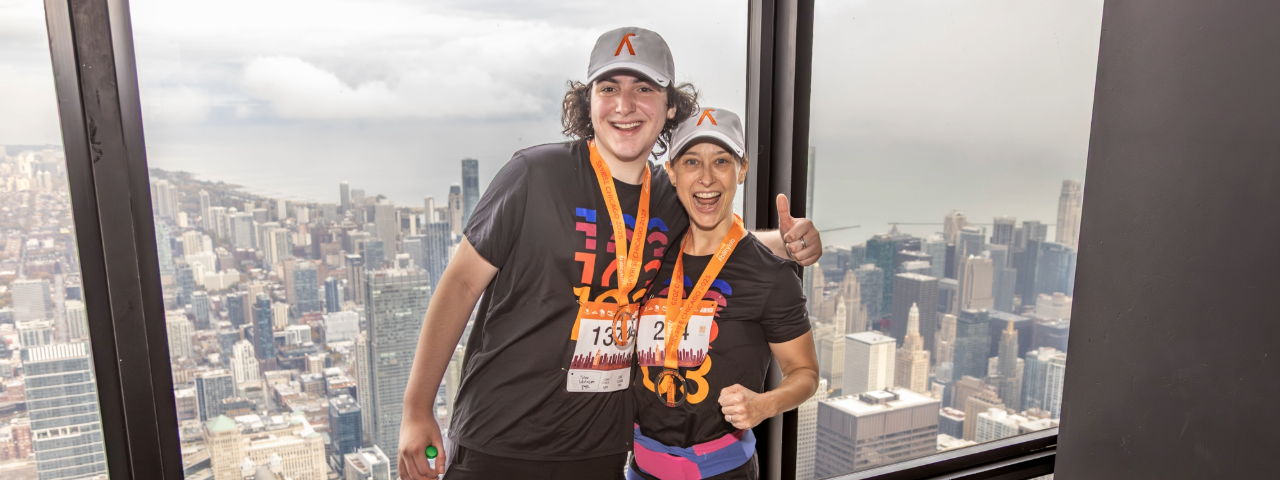Body
Working in the Henry B. Betts LIFE Center — Shirley Ryan AbilityLab's multimedia education center for patients, families, health professionals and the community — I am given the opportunity to assist people who have experienced injuries and traumatic events that changed their lives, altered their perception of self-image, and impacted how others interact with them.
Body
It is important during our connections with others that we do our best to use person-first language: it's both to show respect to individuals with impairments, and to recognize that people are not defined by their conditions.
When I started working on a new reference guide for the LIFE Center on inclusive language, I sought out the assistance of Courtney G., a digital content specialist at Shirley Ryan AbilityLab and power wheelchair user. Before COVID and work-from-home initiatives, I would see her wheeling around, always dressed fashionably with a smile. I asked Courtney for her input to help to create the language style section for People with a Disability in our guide: Language - Etiquette Guides for Reference.

Here is an excerpt of our conversation about her experiences.
Lori S.: Courtney, when I was writing our style guide, I was replacing one that had grown outdated, as language has changed quite a bit over the years. It was important to me that this section include contributions by someone who has this experience. What can you say about how our society has changed linguistically in recent years to accommodate people with a disability?
Courtney G.: I think within your own question, you can see how some of this language and ways of collaborating with people with a disability have evolved. It is so much more inclusive, so to your point of wanting to have a person with a disability contribute to this guide, it says a lot about the way that we have shifted toward genuine inclusivity.
Because of this, there is more of a focus on people with disabilities as, above all, people. I am not a wheelchair, and my life is not defined by my wheelchair. I am a wheelchair user, and the language guide reflects a focus on the person, while also considering what their needs may be.
It’s also a lot more positive. Phrases like “suffers from” and “confined to” give disability a really negative image. That’s not to say there are not difficult parts of living with a disability. But it’s also important for people to know that I do not feel “confined” to my wheelchair — if anything, I’m liberated by it! I wouldn’t be able to leave my bed without it! So it’s unnaturally negative and doesn’t make sense to assign negative language to disability.
It’s important to emphasize that this should all feel a lot more human, and will continue to evolve in that way. Many people feel like the “rules” of etiquette are always changing to the point where it is simply impossible to keep up, and it's better to just avoid the topic altogether. But I would argue that it’s actually more simple than ever; just put the person first. As an accessibility need comes up, address it openly. But, first and foremost, remember: they are human, you are human, and all anyone needs to worry about is speaking to each other kindly.
LS: What do your friends and family do to help you that you would like to share with others?
CG: I think the key with friends and family is open communication. This doesn’t mean that I need to be an open book with them, but I take it on as my responsibility to tell others what I may need help with or what may be challenging for me. In turn, they feel a lot more comfortable to ask me about my needs and preferences, and how they can help. They also learn what to anticipate and how to address it, so every gathering isn’t a logistical nightmare. Many extended family members own wheelchair ramps now. And many friends plan earlier dinners, so I can take transportation home at a safer hour.
When I was in school, I was still able to walk independently, but I had low muscle tone so I fell easily and my injuries could be pretty drastic. A small trip could turn into a broken leg. As a precaution, every year, my mom would come to my classroom and help me tell my classmates about my disability and why it’s so important to not push me, or play rough with me, or do things that kids tend to do. In hindsight, what we were doing was just opening up the lines of communication so everyone felt comfortable and could anticipate what I needed to stay safe. It was such a simple thing that was a lifesaver at that age.
I’ve used a similar model throughout my life, of trying to be proactively upfront with people, be it friends, family, teachers or coworkers. Not everyone feels comfortable with this, and that is completely OK. The key is feeling comfortable to communicate openly and, for those interacting with someone with a disability, beginning to learn the pattern of what someone may need help with so you can anticipate barriers to access.
LS: I grew up with several family members who used wheelchairs. In retrospect, I see that my family had a difficult time accommodating them for family reunions, and selecting restaurants or events that could accommodate their wheelchairs. What can you share that could help family members understand and accommodate a person with a disability (PWD) better?
CG: You are absolutely right that family gatherings present huge challenges and potentially awkward situations. Many homes aren’t accessible, or lack an accessible bathroom. I’ve been in many of these situations, but there are preventative measures that can be made both by family members and people with disabilities.
For families, it's important to remember that, in most cases, people with disabilities want to be included. I find myself having to turn down group dinners or gatherings because they are inaccessible, and I’ll usually take the route of making the host feel like this isn’t a big deal. I’m not saying this is the right thing to do — I’m just “picking my battles” if you will. But, to be honest, it hurts! I want to be included, and when situations like this do occur, it can damage a relationship.
The best practice to avoid situations like this is open communication between the host and the attendee with a disability. The host should take the lead in reaching out to the person with a disability and tell them what they’d like to do for the event, and ask how they can do it in a way that is accessible. This will differ depending on the person. For myself, it means going to restaurants that are wheelchair accessible; bringing wheelchair ramps to homes with steps (or having the host rent one); allowing for extended bathroom breaks every four hours; having access to an accessible bathroom; or, if there is no accessible bathroom, limiting the gathering time to four to five hours.
Then, make a plan together of how to create accessible solutions. For instance, if the host knows me well, I’ll let them take on the responsibility of perhaps calling the restaurant to ask if they are wheelchair accessible, or investigating ramp rental options. If the host does not know me well, or I think I would do a better job at the “investigating,” then I’ll take on that job.
Another key is to take the word of the person with a disability on what they are comfortable with in terms of assistance. I, personally, am not comfortable with friends helping me to the bathroom, and would rather have an assistant help. So, if a friend says, “Don’t worry, I can help you to the bathroom,” it’s a very kind offer, but not an accessible solution for me. Other common “non-solutions” include offering to carry a wheelchair user up a set of steps, or offering to “fit” a wheelchair in a small car. Never ask someone to risk their safety or comfort to attend an event.
Additionally, a really important part of accessibility that many people don’t consider is that people with disabilities sometimes need personal assistants to come with them. For larger events like weddings that have invite caps, guests with disabilities may need a plus-one just so they can attend. For events that require travel, remember that people with disabilities will need an extra plane ticket and hotel room for personal assistants. Keeping events local is sometimes the best way to keep them accessible.

LS: What business would you like to change to accommodate PWD better?
CG: This is such an interesting time for this question! (NOTE: This conversation was recorded during the COVID-19 pandemic, when much of the country is locked down.) We’re seeing this massive trend of people working from home for their health and safety, large-scale events going virtual, and colleges and schools offering more online options. For a long time, people with disabilities have been unable to take on certain jobs, or attend conferences that present travel or accessibility challenges, or achieve higher levels of education. Now, all of sudden, in a matter of months, all of this has moved online and is right at our fingertips.
So to answer your question, I don’t know if I have a specific business that I’d target as egregiously inaccessible; there is room for improvement across the board. But I would challenge all business leaders to recognize how much could be made virtual, and to be more open to virtual accessible solutions.
One of the reasons I left a previous employer was because, as I was promoted, there were more expectations for me to travel to client offices for presentations. These trips were extremely stressful — from securing a personal assistant who could block off several days to travel with me, to finding accessible hotel rooms (on one trip, my reservation was lost and the only rooms left lacked an accessible bathroom; I had to go to a restaurant across the street to use the bathroom and brush my teeth, and was unable to shower), to ensuring that there was no damage to my wheelchair after plane travel (on one occasion, my wheelchair came off the plane completely inoperable) — I simply couldn’t take the immense burden of stress that I felt from these trips. The only reason we took these trips were to give presentations that could have been just as effective over video chat, and could have saved the clients thousands of dollars and many, many hours!
LS: What is the biggest point you would like to share with people to bring better connection and awareness to PWD?
CG: It may sound a bit obvious, but the biggest point is that, above all, we are people! This means that, while we may share a collective experience, we are not all the same. Some people may be more comfortable answering questions, or proactive in planning, or upfront when a problem arises than others.
It also means that we make mistakes. Just because someone has a disability does not mean that their way of handling every situation will be perfect — we’re trying to figure it out, too! It also doesn’t mean that people with disabilities have an accessible solution to every problem. Solutions may take teamwork and brainstorming as a group to find.
And finally, it means that our needs are legitimate and our concerns are valid. If someone needs to work from home, or needs scheduled bathroom breaks throughout the day, they’re not making it up! This is a request for accessibility, and should be accepted and honored in the same way that we accept wheelchair users need elevators.
All of these reasons are why clear communication and inclusive collaboration are essential. If everyone is clear with their needs, those needs are honored, and we work together to find a solution for all, really amazing things can happen.
Courtney G. is a writer and communications strategist based in Chicago. She is a digital content specialist for Pathways.org, and serves as a peer mentor at Shirley Ryan AbilityLab. Courtney has Spinal Muscular Atrophy and uses a power wheelchair as a mobility aid. She is the proud mom of Topo, a very noisy cat.
Lori S. is a medical librarian at Shirley Ryan AbilityLab's Henry B. Betts LIFE Center, where she assists patients, families and staff with information needs and research support. She enjoys spending her spare time with her family and birds, and is a priest in the Zen Buddhist community.

